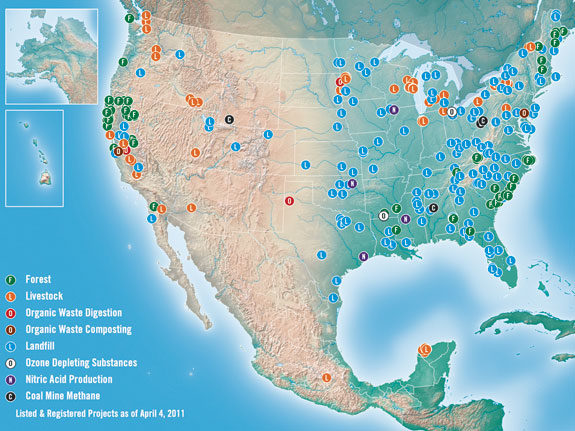One of the many benefits of using anaerobic digestion for management of livestock manure is the destruction of methane, a highly potent greenhouse gas (its heat-trapping abilities are 21 times greater than CO2). For more than a decade, it has been possible for livestock operations to generate carbon offsets for this methane reduction when they replace their open manure lagoon systems.
A dairy operation should be able to generate two to four offset credits per cow per year, on average. Unfortunately, historically, the carbon market has been defined by a great deal of change and variability, generating uncertainty in the financial models for digester projects.
Over the last couple of years, however, more voluntary buyers of carbon offsets have entered the market, and they have been shifting their preferences towards offset programs that utilize stringent standards and operate in an open and transparent manner. The state of California has also been developing its cap-and-trade program, creating a new market for carbon offsets to be used for compliance.
For livestock operators, this means there is both growth and stability in the demand for their credits, which is coupled with rising prices. Prices for livestock CRTs have recently been in the range of $8 to $9 each (as of late March; this is subject to change).
The Climate Action Reserve is a non-profit carbon offsets program that develops high-quality, conservative standards and maintains a project registry through which serialized Climate Reserve Tonnes (CRTs) are issued, transferred and retired. The initial Livestock Project Protocol was developed in 2007, and has received periodic updates and revisions since that time.
There are currently 65 dairy and swine manure digester projects that have been submitted from 17 different U.S. states, as well as seven projects submitted from Mexico. Together, these projects have generated more than a quarter of a million CRTs, and more are on the way.
California compliance market
The state of California adopted Assembly Bill 32, the Global Warming Solutions Act, in 2006. As part of this law, the California Air Resources Board developed a scoping plan to detail the actual regulations that would be put in place in order to achieve the goals of AB32.
A statewide cap-and-trade regulation was developed and then adopted by the ARB in December of 2010. This program is scheduled to begin in 2012 and run through 2020.
The main component of the California compliance market will be tradable emissions permits known as allowances. However, the regulation also includes a provision that allows emitters to use carbon offsets for up to 8 percent of their emissions for each year.
So far the ARB has adopted four of the Reserve’s project protocols for use in creating these compliance offsets: livestock, forestry, urban forestry, and ozone-depleting substances.
These projects may be located anywhere in the United States. This means that a dairy manure digester project in Wisconsin may generate offsets and sell them into the California market.
The potential market demand for offset credits in California will be 13 million tonnes per year for the first three years, rising to almost 30 million tonnes per year for the remainder of the program. The regulation includes a minimum price of $10 per tonne for allowances, so offset projects can expect similar prices when they sell their credits.
Some estimates have predicted that allowance prices will rise above $50 per tonne by the end of the program.
How to get involved
The Reserve’s Livestock Project Protocol outlines all of the eligibility requirements for livestock projects. Only new digester projects are eligible (you must submit the necessary paperwork to the Reserve no later than six months after your project is operational), and the manure must have previously been managed in an open, uncontrolled anaerobic lagoon (or storage tank).
The biogas that is generated by the digester may be destroyed on-site or off-site; there is no prescription about how it is utilized. For projects that wish to co-digest manure with other organic waste, there is also an Organic Waste Digestion Project Protocol.
The livestock protocol gives guidance about monitoring and metering requirements, and it will be much easier to comply with these if they are incorporated into the design of the digester project. Start early on the development of a monitoring plan to make sure that you have the proper equipment for metering gas flow and methane concentration, as well as the operating hours of your engine, flare or other destruction system.
At least every two years, every livestock project must go through verification by an independent third party. It is only after this verification is successful that CRTs are issued, and this process is much easier if the project is prepared.
The carbon markets are strong and have a high demand for livestock CRTs, and digester technology has matured greatly in the past few years. There are many resources available to farmers who want to learn more and get involved. The timing has never been better for livestock operations that wish to install manure digesters. PD
References omitted due to space but are available upon request to editor@progressivedairy.com .
Check it outThere are a number of resources available to learn more about carbon offsets and the Livestock Project Protocol.
• On the Reserve website, www.climateactionreserve.org , you can download the protocol, as well as access videos and slides from previous presentations about livestock carbon projects.
• There is also a page called the CRT Marketplace, which provides links to companies involved with buying and selling CRTs, who can help a project learn more about accessing the financial markets for their CRTs.
• Lastly, for folks that are attending the Sixth AgSTAR National Conference in Boise, Idaho, there will be a free carbon credits workshop on Tuesday, May 10, from 2 to 5 p.m. More information is available from the Reserve’s events calendar on the website.
Max DuBuisson
Policy manager
Climate Action Reserve
max@climateactionreserve.org




